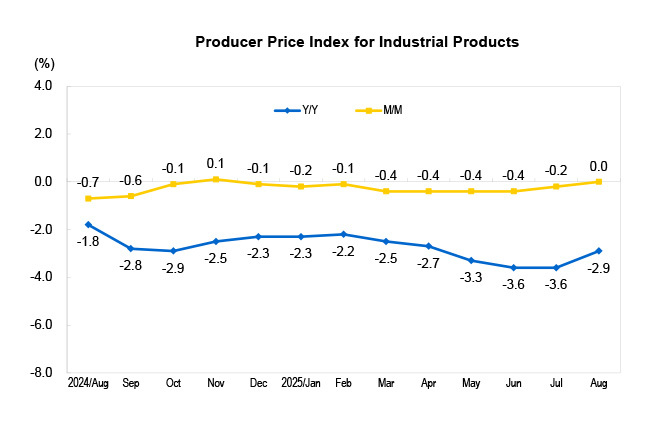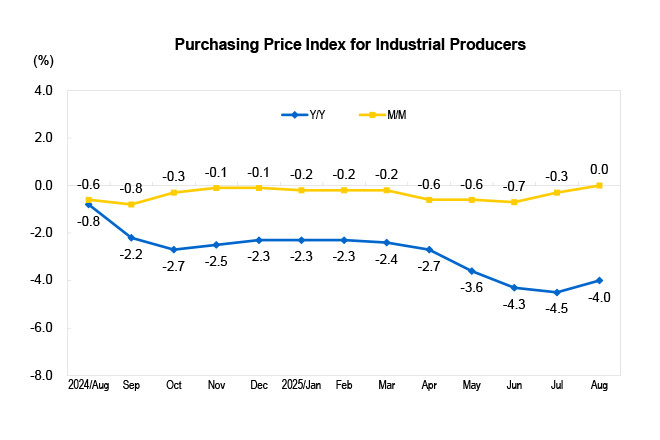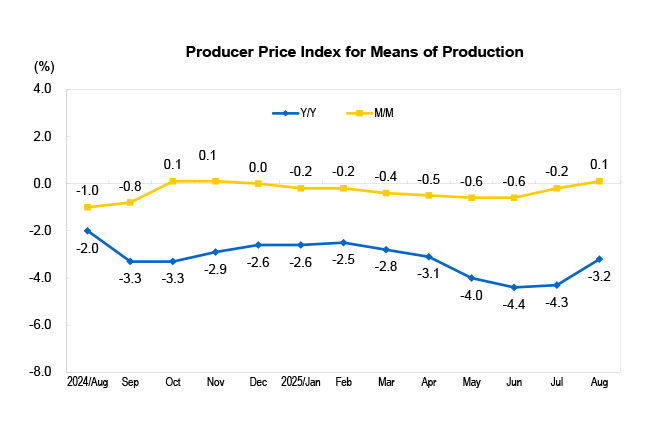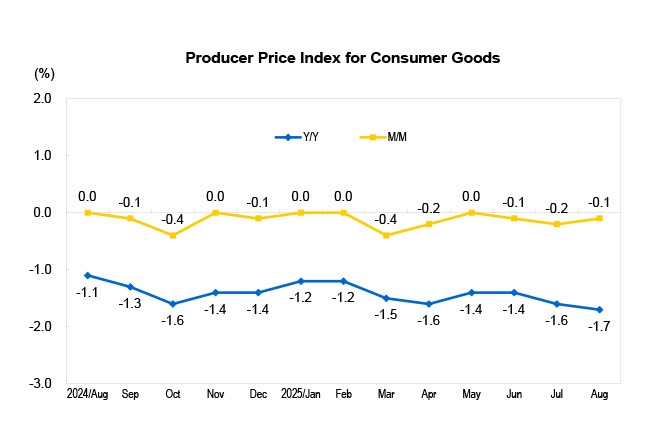Industrial Producer Price Indexes in August 2025
In August 2025, China’s producer price index for industrial products fell by 2.9% year on year, with the decline narrowing by 0.7 percentage points from the previous month, while the month-on-month change turned from a 0.2% decrease to flat. Purchasing price index for industrial producers decreased by 4.0% year on year, remaining flat month on month. From January to August, on average, producer price index for industrial products reduced by 2.9% year on year, while purchasing price index for industrial producers dropped by 3.3%.


I. Year-on-Year Changes in Industrial Producer Price Indexes
In August, among producer price indexes for industrial products, the price index for means of production fell by 3.2%, pushing the overall producer price index for industrial products down by about 2.40 percentage points. Specifically, the price index for mining and quarrying decreased by 11.5%, that for raw materials dropped by 4.1%, and that for the processing industry declined by 2.2%. The price index for consumer goods decreased by 1.7%, pushing the overall producer price index for industrial products down by about 0.45 percentage points. Moreover, the price index for food fell by 1.7%, that for clothing remained flat, that for articles for daily use rose by 0.4%, and that for durable consumer goods declined by 3.7%.


Among purchasing price indexes for industrial producers, the price index for fuel and power fell by 9.7%, that for raw chemical materials reduced by 6.2%, those for both ferrous metals and agricultural products decreased by 5.6%, that for building materials and non-metals declined by 4.7%, and that for textile materials fell by 2.0%. In contrast, that for nonferrous metals and cables rose by 4.7%.
II. Month-on-Month Changes in Industrial Producer Price Indexes
In August, among producer price indexes for industrial products, the price index for means of production rose by 0.1%, pushing the overall producer price index for industrial products up by about 0.08 percentage points. Specifically, the price index for mining and quarrying increased by 1.3%, that for raw materials grew by 0.2%, while that for the processing industry remained flat. The price index for consumer goods fell by 0.1%, pushing the overall producer price index for industrial products down by about 0.03 percentage points. Among them, the price index for food rose by 0.1%, that for clothing remained flat, while that for articles for daily use declined by 0.2%, and that for durable consumer goods decreased by 0.3%.
Among purchasing price indexes for industrial producers, the price index for building materials and non-metals fell by 1.4%, while that for raw chemical materials and agricultural products both dropped by 0.4%. In contrast, the price index for fuel and power grew by 0.7%, that for ferrous metals rose by 0.6%, and those for nonferrous metals and cables as well as textile materials both increased by 0.1%.
Industrial Producer Price Indexes in August 2025
|
|
Growth Rate M/M (%) |
Growth Rate Y/Y (%) |
Jan-Aug Growth Rate Y/Y (%) |
|
I. Producer Price Indexes for Industrial Products |
0.0 |
-2.9 |
-2.9 |
|
0.1 |
-3.2 |
-3.4 | |
|
Mining and quarrying |
1.3 |
-11.5 |
-9.9 |
|
Raw materials |
0.2 |
-4.1 |
-3.7 |
|
Processing |
0.0 |
-2.2 |
-2.7 |
|
Consumer goods |
-0.1 |
-1.7 |
-1.4 |
|
Food |
0.1 |
-1.7 |
-1.6 |
|
Clothing |
0.0 |
0.0 |
-0.1 |
|
Articles for daily use |
-0.2 |
0.4 |
0.6 |
|
Durable consumer goods |
-0.3 |
-3.7 |
-3.2 |
|
II. Purchasing Price Indexes for Industrial Producers |
0.0 |
-4.0 |
-3.3 |
|
Fuel and power |
0.7 |
-9.7 |
-8.2 |
|
Ferrous metals |
0.6 |
-5.6 |
-7.7 |
|
Nonferrous metals and cables |
0.1 |
4.7 |
6.8 |
|
Raw chemical materials |
-0.4 |
-6.2 |
-5.0 |
|
Timber and paper pulp |
-0.3 |
-4.0 |
-3.4 |
|
Building materials and non-metals |
-1.4 |
-4.7 |
-2.5 |
|
Other industrial raw materials and semi-products |
0.0 |
-1.8 |
-1.7 |
|
Agricultural products |
-0.4 |
-5.6 |
-3.7 |
|
Textile materials |
0.1 |
-2.0 |
-2.1 |
|
III. Producer Price Indexes for Major Industries |
|
|
|
|
Mining and washing of coal |
2.8 |
-19.8 |
-16.9 |
|
Extraction of petroleum and natural gas |
-1.1 |
-9.7 |
-10.0 |
|
Mining and processing of ferrous metal ores |
2.1 |
-5.3 |
-9.4 |
|
Mining and processing of non-ferrous metal ores |
0.8 |
11.8 |
16.0 |
|
Mining and processing of non-metal ores |
-0.5 |
-3.1 |
-1.0 |
|
Processing of food from agricultural and sideline products |
0.4 |
-2.9 |
-3.5 |
|
Manufacture of foods |
-0.3 |
-1.2 |
-1.2 |
|
Manufacture of liquor, beverages and refined tea |
-0.5 |
-0.7 |
-0.7 |
|
Manufacture of tobacco |
0.0 |
0.4 |
0.4 |
|
Textile industry |
0.1 |
-2.4 |
-2.4 |
|
Manufacture of textile, wearing apparel and accessories |
0.0 |
-0.3 |
-0.2 |
|
Processing of timber, manufacture of wood, bamboo, rattan, palm, and straw products |
0.0 |
-3.5 |
-2.8 |
|
Manufacture of paper and paper products |
-0.3 |
-3.5 |
-3.2 |
|
Printing and reproduction of recording media |
-0.1 |
-1.8 |
-1.6 |
|
Processing of petroleum, coal and other fuels |
0.7 |
-10.5 |
-10.3 |
|
Manufacture of raw chemical materials and chemical products |
-0.1 |
-5.7 |
-4.9 |
|
Manufacture of medicine |
-0.5 |
-2.9 |
-1.8 |
|
Manufacture of chemical fibers |
-0.6 |
-9.3 |
-6.5 |
|
Manufacture of rubber and plastics products |
-0.4 |
-2.6 |
-1.9 |
|
Manufacture of non-metallic mineral products |
-1.0 |
-5.4 |
-3.7 |
|
Smelting and pressing of ferrous metals |
1.9 |
-4.0 |
-9.5 |
|
Smelting and pressing of non-ferrous metals |
0.2 |
4.8 |
5.5 |
|
Manufacture of metal products |
-0.2 |
-2.3 |
-2.3 |
|
Manufacture of general purpose machinery |
-0.1 |
-1.7 |
-1.4 |
|
Manufacture of automobiles |
-0.3 |
-2.7 |
-2.9 |
|
Manufacture of railway, ship, aerospace and other transport equipment |
-0.2 |
-0.5 |
0.0 |
|
Manufacture of computers, communication equipment and other electronic equipment |
-0.2 |
-2.4 |
-2.2 |
|
Production and supply of electricity and heat power |
0.1 |
-1.6 |
-1.5 |
|
Production and supply of gas |
-0.2 |
-0.4 |
-0.7 |
|
Production and supply of water |
0.7 |
2.4 |
1.3 |
Annotations:
1. Index Interpretation
The Industrial Producer Price Index comprises the Producer Price Index for Industrial Products (PPI) and the Purchasing Price Index for Industrial Producers.
The PPI reflects the trend and magnitude of changes in the producer prices for products when they are sold for the first time by industrial enterprises.
The Purchasing Price Index for Industrial Producers reflects the trend and magnitude of changes in the prices for intermediate inputs purchased by industrial enterprises.
2. Statistical Coverage
The statistical survey of producer price index for industrial products covers prices for 40 major industrial sectors and more than 1,300 basic categories of industrial products; the statistical survey of purchasing price index for industrial producers covers prices for 9 major categories and over 800 basic categories of industrial products.
3. Survey Methods
The survey of industrial producer price index employs a method that combines key-point surveys and typical surveys, covering more than 40,000 industrial enterprises across China.
4. Statistical Standard
The industries are classified in accordance with the Industrial Classification for National Economic Activities (GB/T4754-2017).
5. Data Description
Due to rounding-off, the aggregated data may be equal to the high or low value of the classified figures. For some categories or industries where price changes are small, the growth or decline rate becomes zero after being rounded off to one decimal place. In such cases, the price change is described as “flat”.
